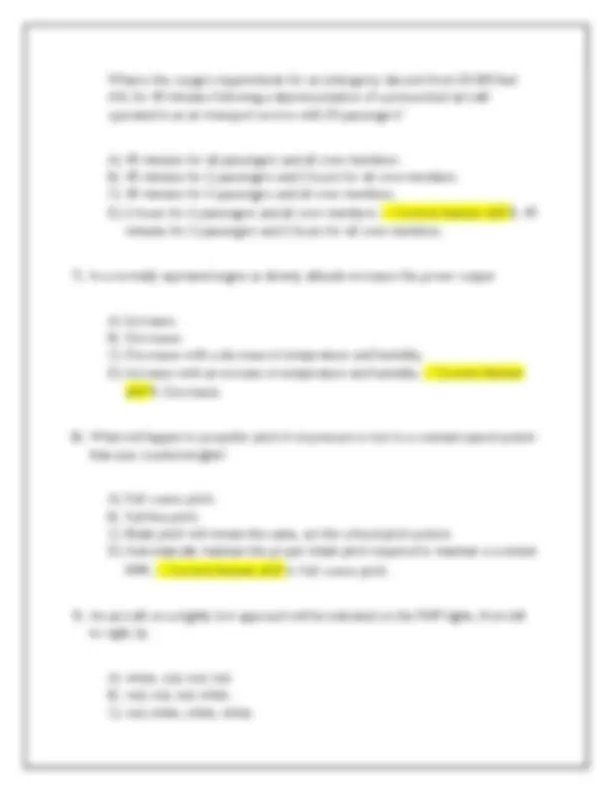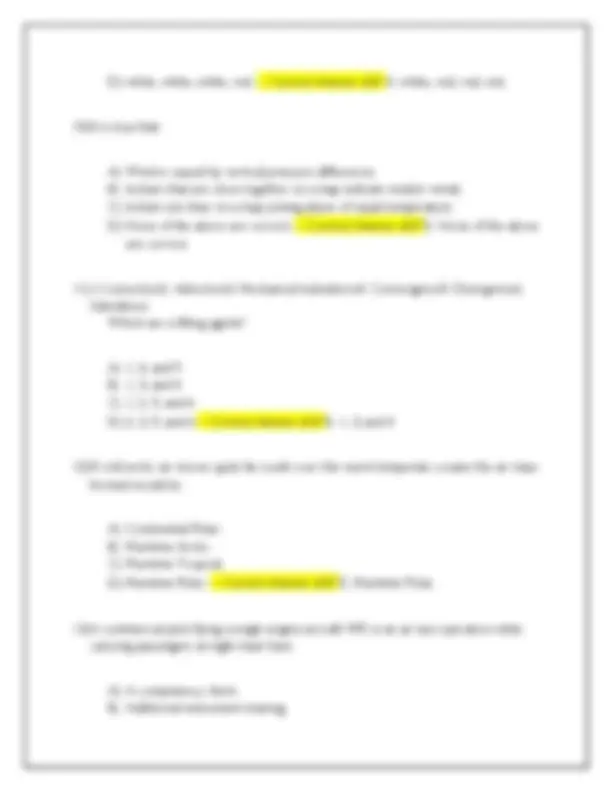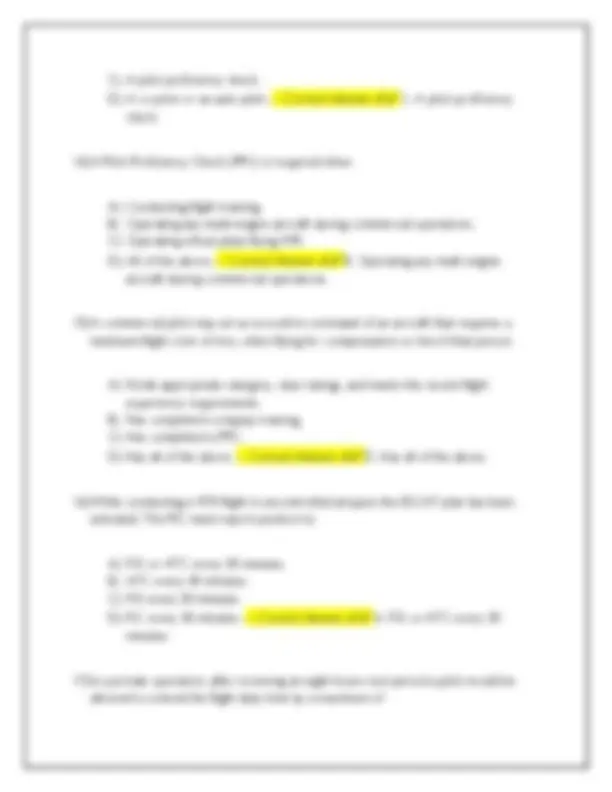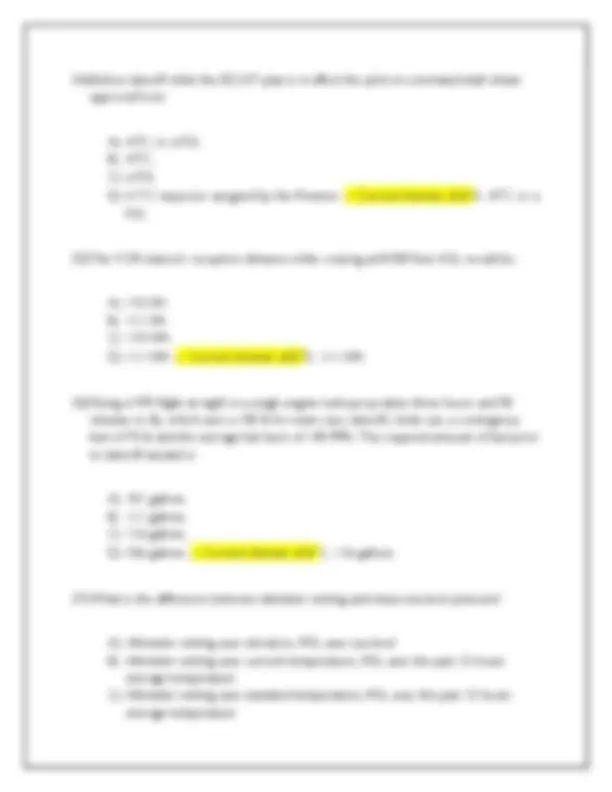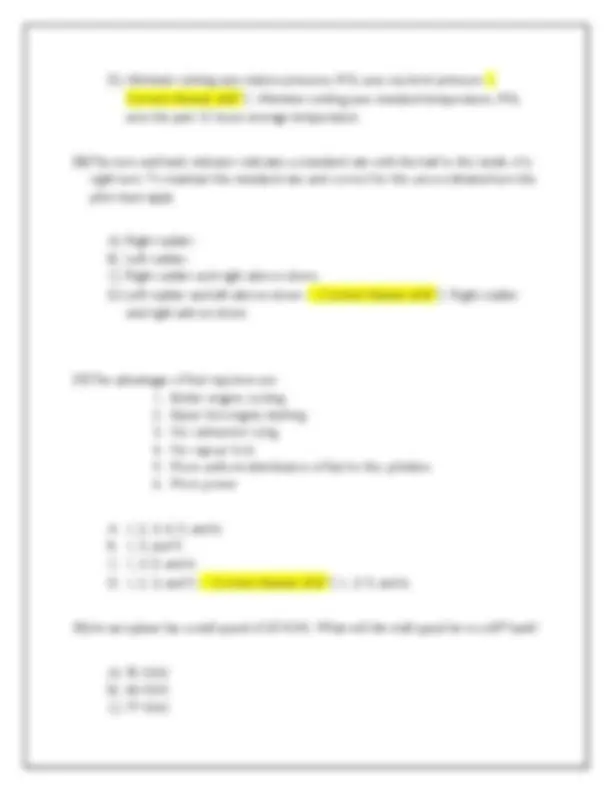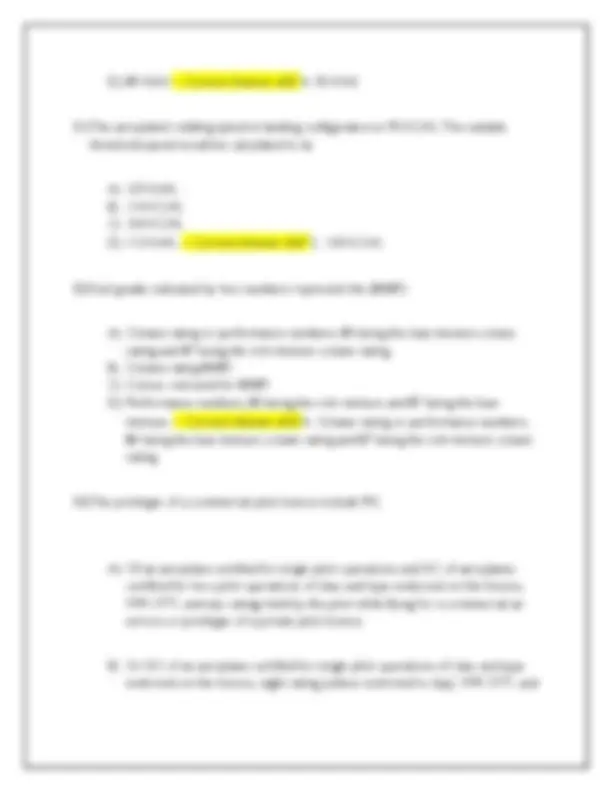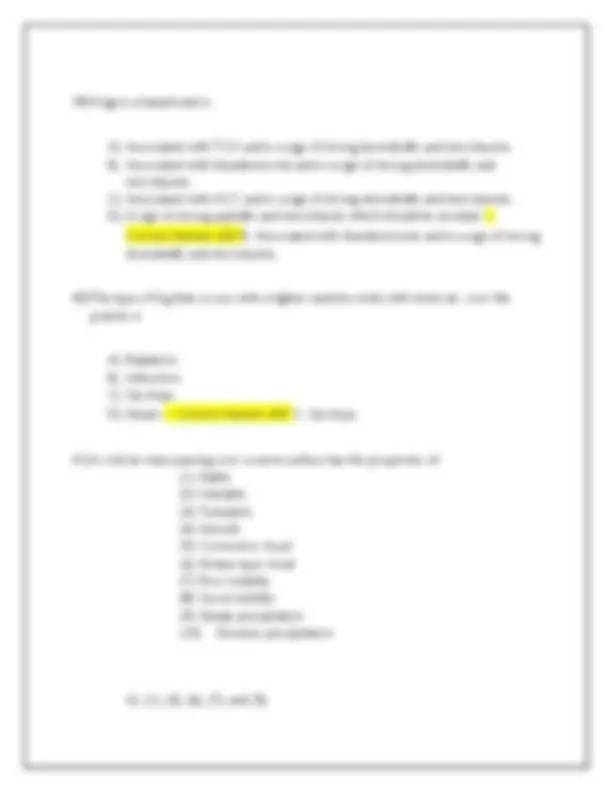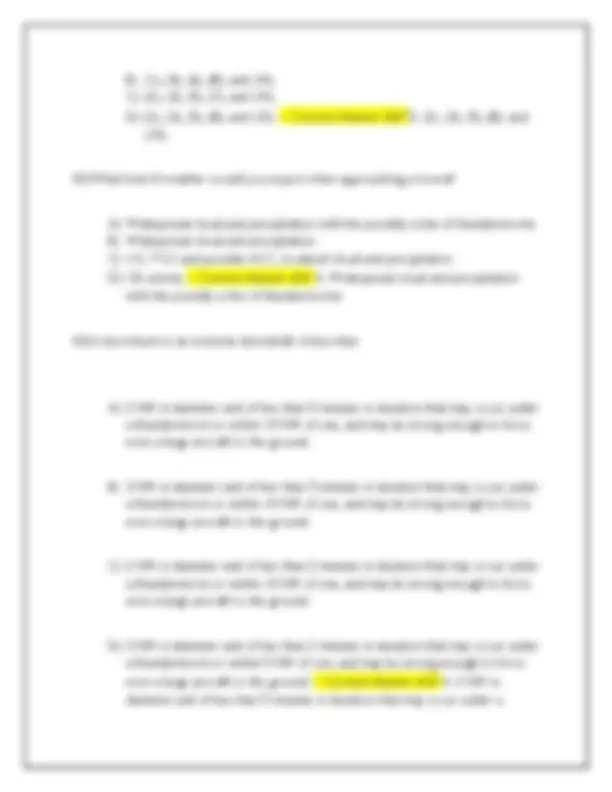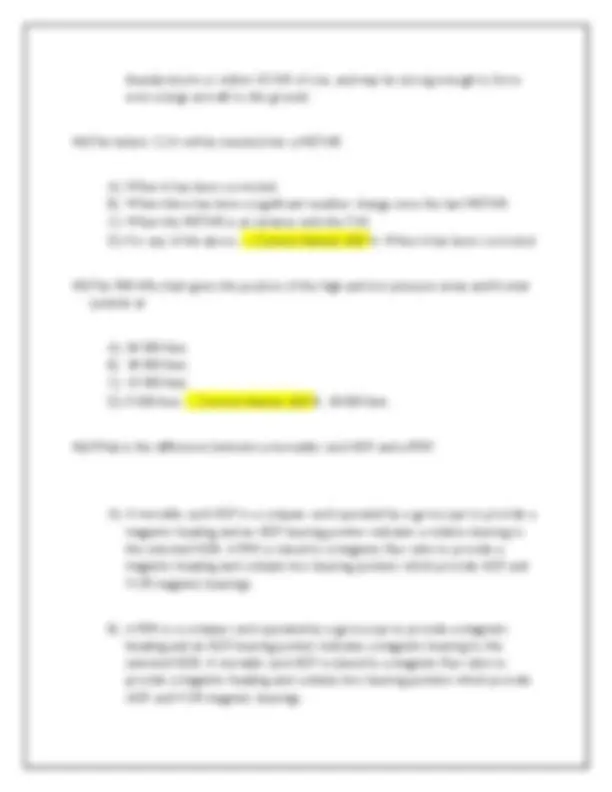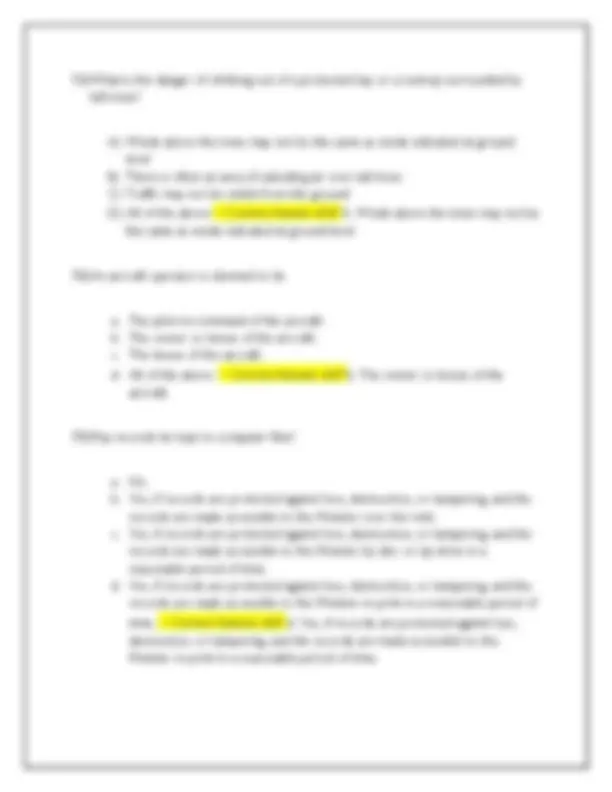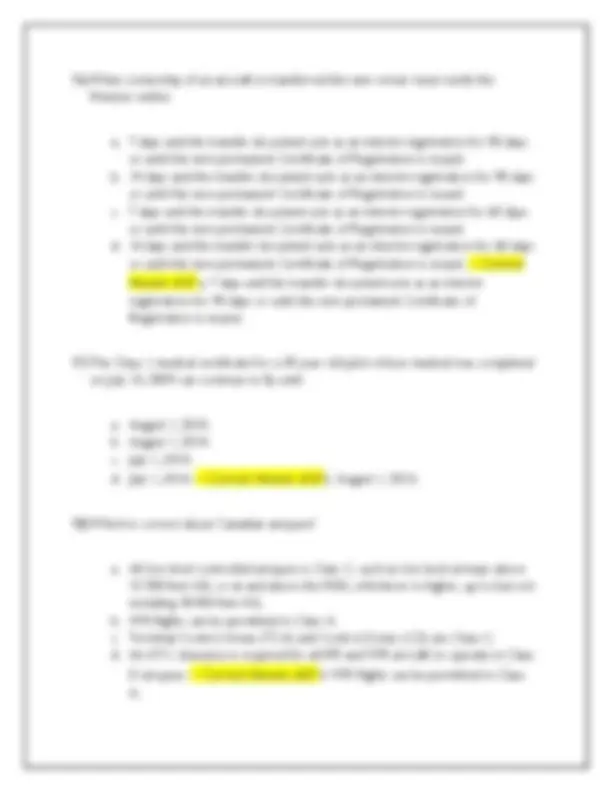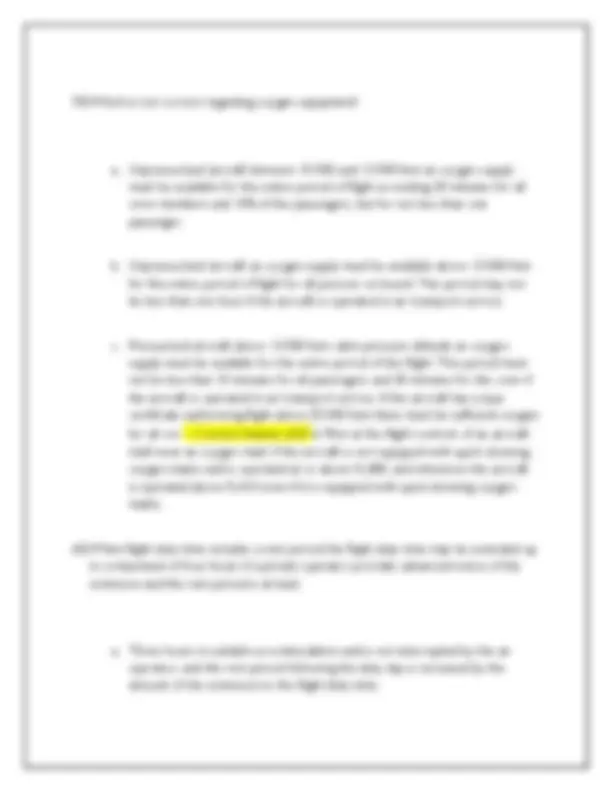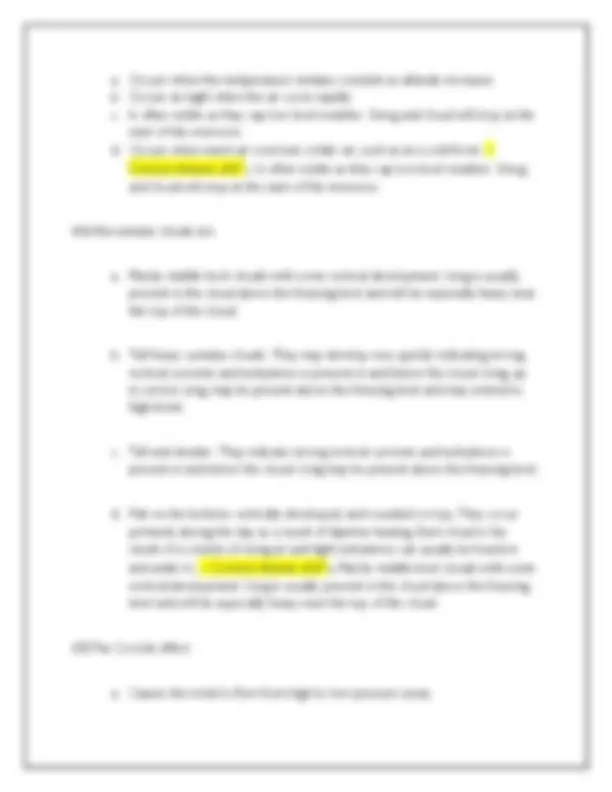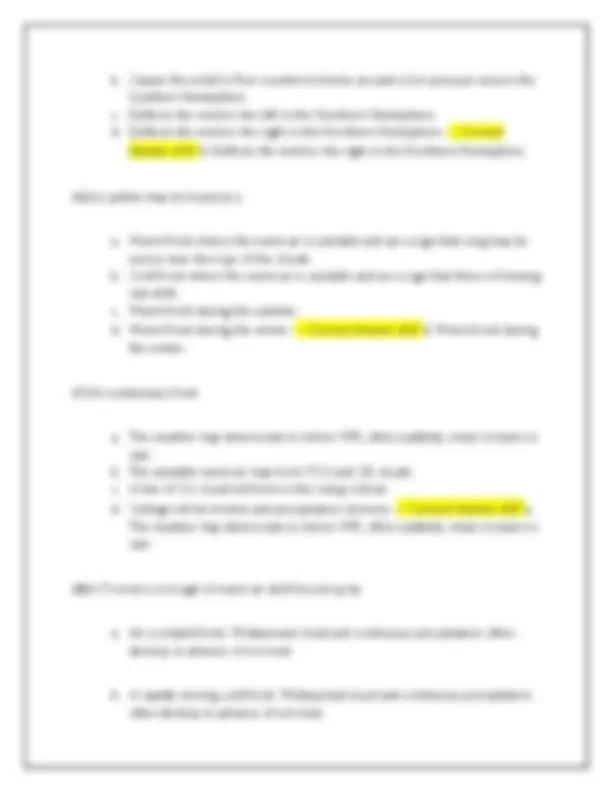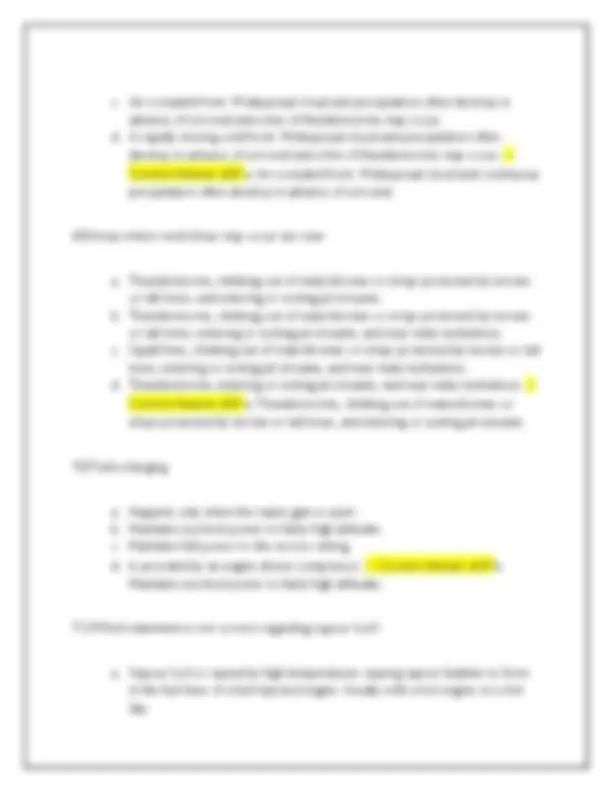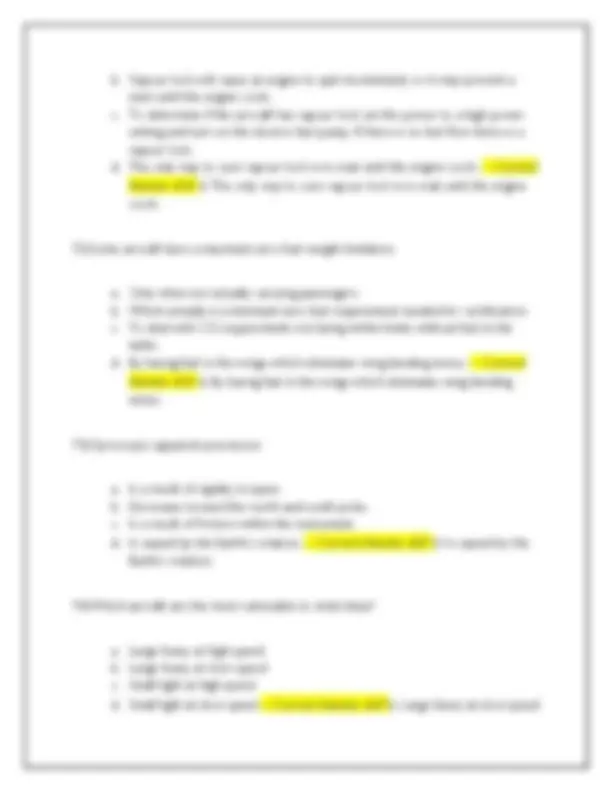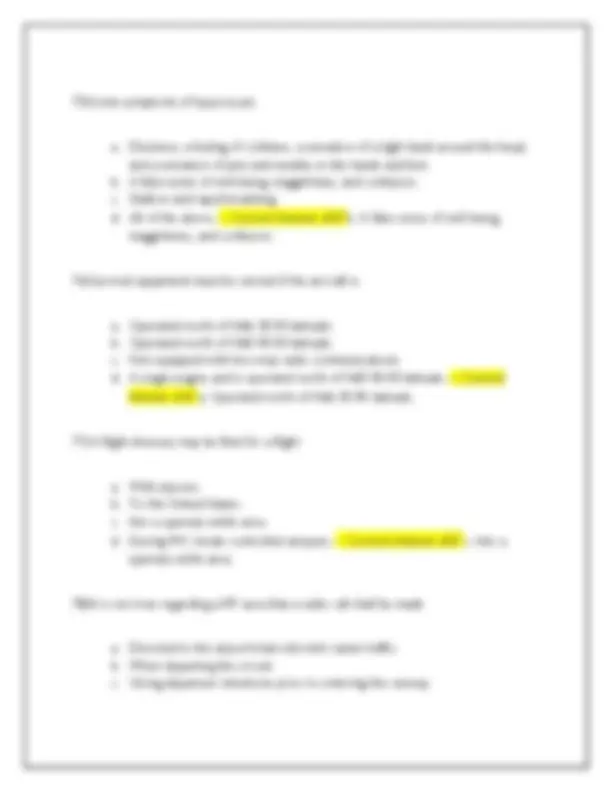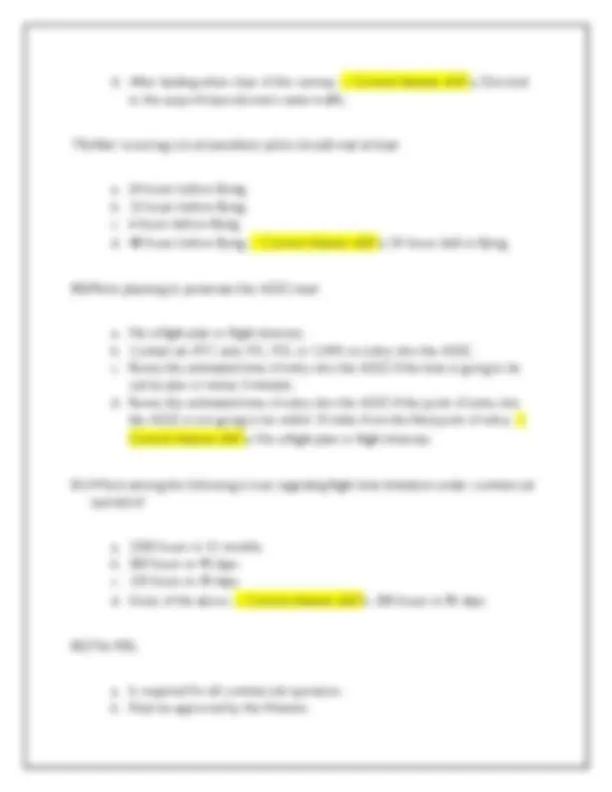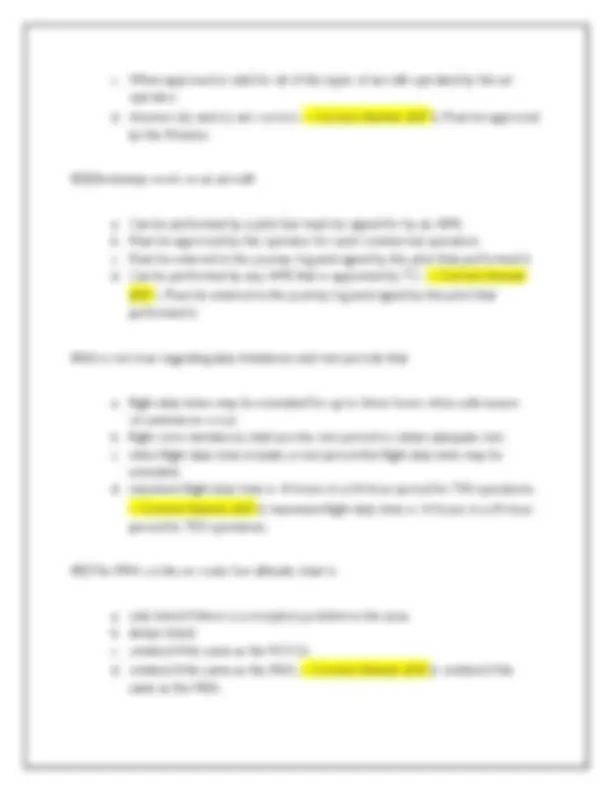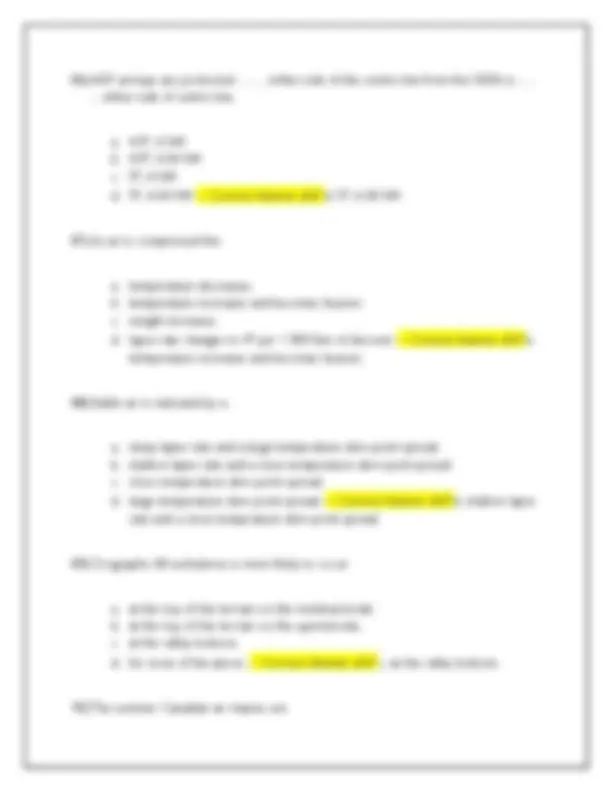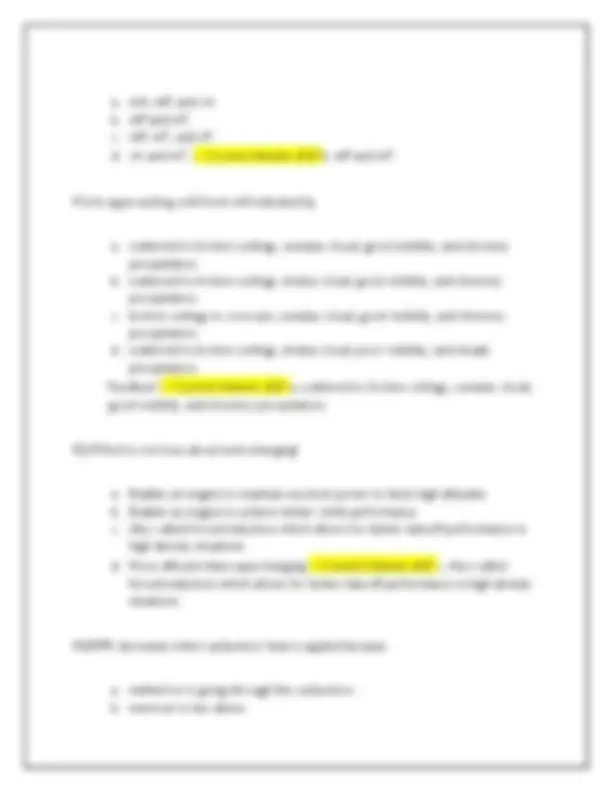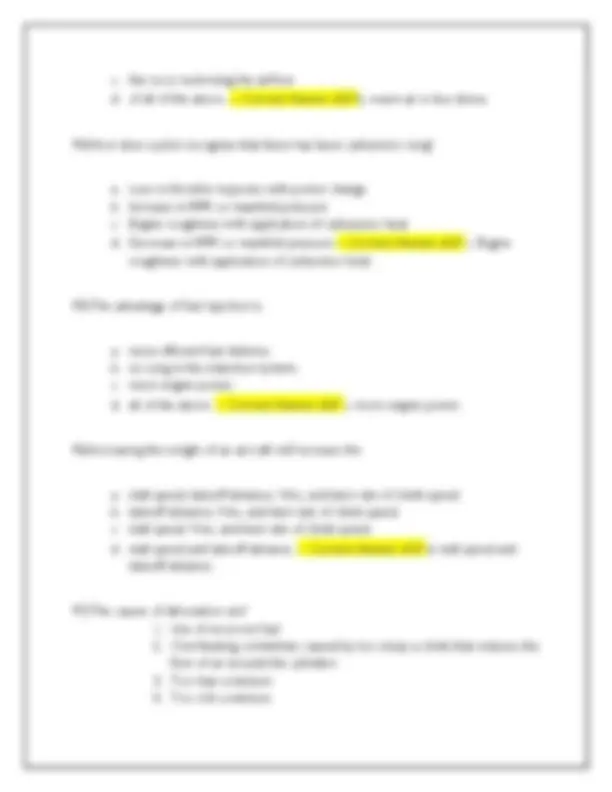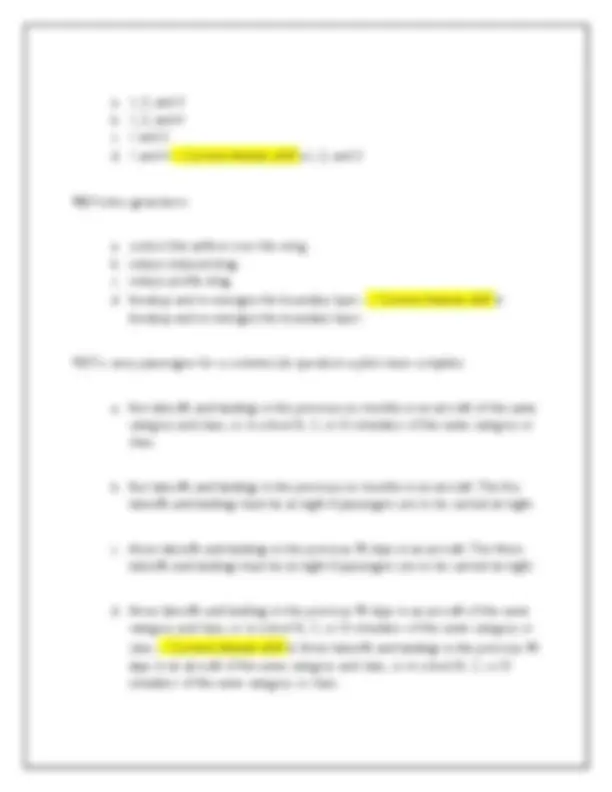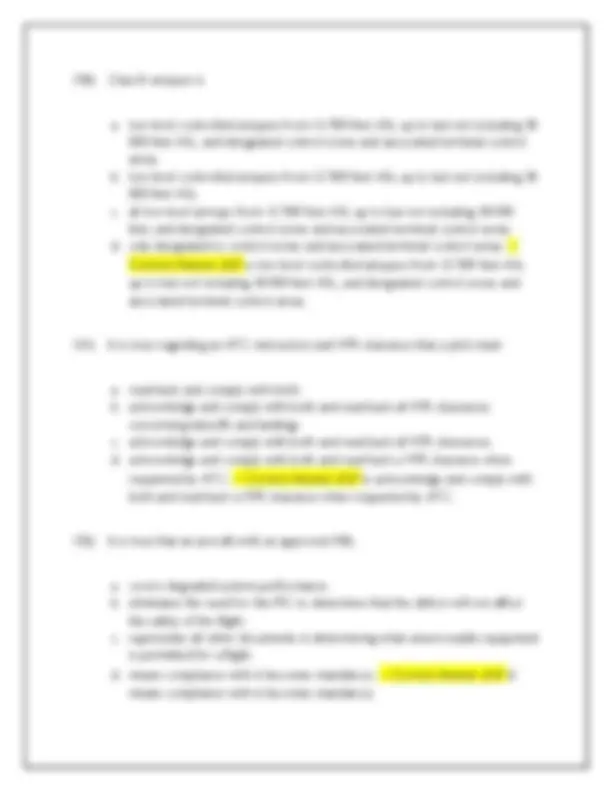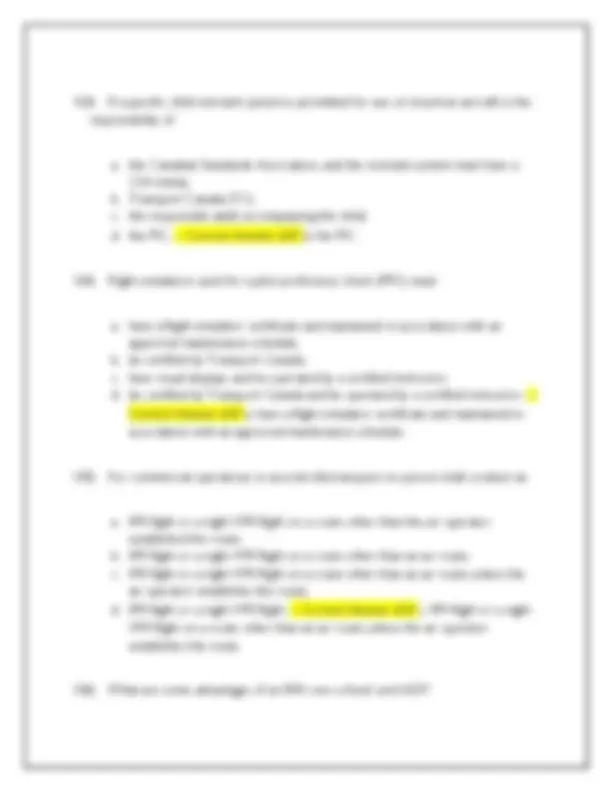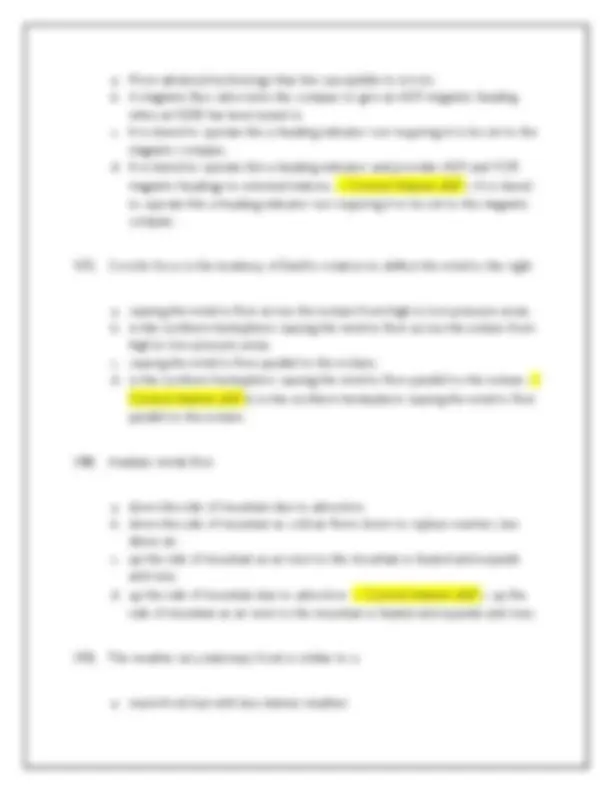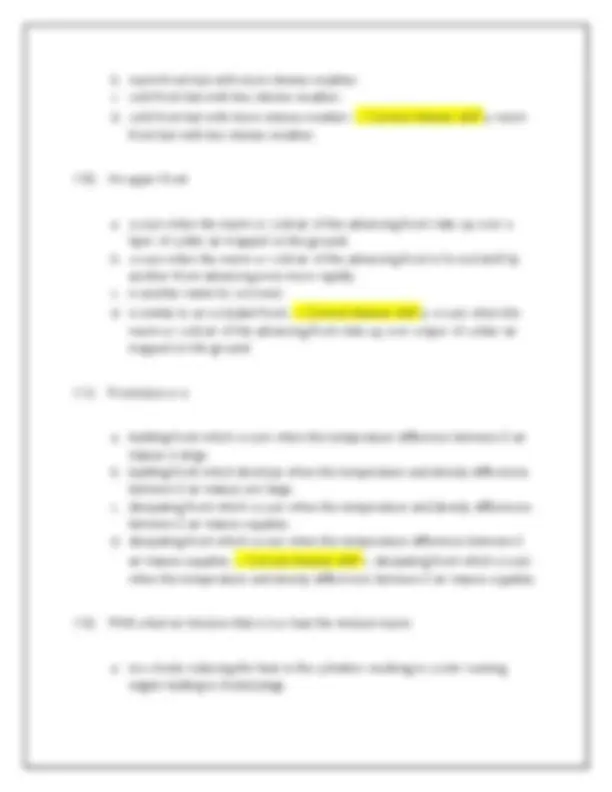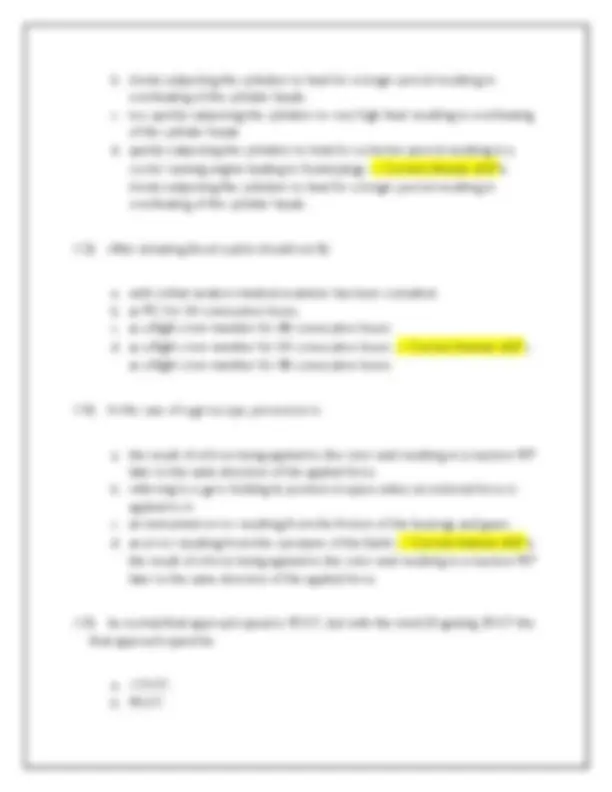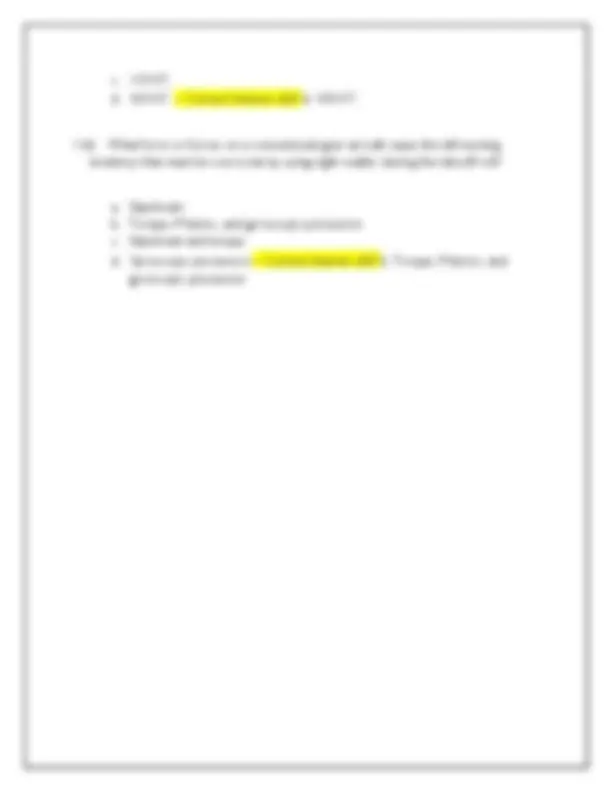Download CPL EXAM PRACTICE QUESTIONS WITH ACCURATE SOLUTIONS and more Exams Engineering in PDF only on Docsity!
CPL EXAM PRACTICE QUESTIONS WITH ACCURATE
SOLUTIONS
- In order to act as pilot-in-command of a two-crew aircraft the pilot must have A) A CPL with a checkout for the aircraft. B) An ATPL with a type rating for the aircraft. C) 50 hours on type. D) The IATRA written with 750 hours and a type rating. -- Correct Answer ✔✔ B. An ATPL with a type rating for the aircraft.
- In order to act as pilot-in-command of a single-engine aircraft for an air taxi service under night VFR without passengers a commercial pilot must have A) Competency check. B) A valid instrument rating and PPC. C) A valid night rating and competency check. D) None of the above. -- Correct Answer ✔✔ A. Competency check.
- The maximum flight duty period of a pilot with a commercial operator depends on
A) The reporting time and the number of flights scheduled during the flight duty period. B) The reporting time only. C) Rest period the pilot got in the previous day. D) The number of sectors only. -- Correct Answer ✔✔ A. The reporting time and the number of flights scheduled during the flight duty period.
- What affect can a few millimeters of ice or frost have on an aerofoil? A) Nothing substantial. B) Wing stall speed could be increased as much as 10 to 30% but the ice or frost does not need to be removed until the stall speed is increased by 50%. C) Increase in the speed and takeoff distance and the ice or frost must be removed before flight. D) Lift decreases by 40% will drag is increased by 30%. -- Correct Answer ✔✔ C. Increase in the speed and takeoff distance and the ice or frost must be removed before flight.
- The minimum lighting required for an aerodrome's movement area at night, is a parallel row of white runway lights visible in flight at a distance of not less than A) Two nautical miles in all directions. B) Two nautical miles in all directions with blue taxiway lights. C) Two nautical miles in all directions, with blue taxiway and parking area lights, and a lighted windsock. D) Two nautical miles in all directions with green threshold and red runway end lights, blue taxiway and parking area lights, and a lighted windsock. -- Correct Answer ✔✔ C. Two nautical miles in all directions, with blue taxiway and parking area lights, and a lighted windsock.
- Average cabin pressure altitude is 11 000 feet ASL and the aircraft type certificate allows for flight above FL250.
D) white, white, white, red. -- Correct Answer ✔✔ A. white, red, red, red.
- It is true that A) Wind is caused by vertical pressure differences. B) Isobars that are close together on a map indicate weaker winds. C) Isobars are lines on a map joining places of equal temperature. D) None of the above are correct. -- Correct Answer ✔✔ D. None of the above are correct.
- 1.Convection2. Advection3. Mechanical turbulence4. Convergence5. Divergence6. Subsidence Which are a lifting agents? A) 1, 4, and 5 B) 1, 3, and 4 C) 1, 2, 5, and 6 D) 2, 3, 5, and 6 -- Correct Answer ✔✔ B. 1, 3, and 4
- If cold arctic air moves quite far south over the warm temperate oceans the air mass formed would be A) Continental Polar. B) Maritime Arctic. C) Maritime Tropical. D) Maritime Polar. -- Correct Answer ✔✔ D. Maritime Polar.
- A commercial pilot flying a single-engine aircraft VFR in an air taxi operation while carrying passengers at night must have A) A competency check. B) Additional instrument training.
C) A pilot proficiency check. D) A co-pilot or an auto-pilot. -- Correct Answer ✔✔ C. A pilot proficiency check.
- A Pilot Proficiency Check (PPC) is required when A) Conducting flight training. B) Operating any multi-engine aircraft during commercial operations. C) Operating a float plane flying VFR. D) All of the above. -- Correct Answer ✔✔ B. Operating any multi-engine aircraft during commercial operations.
- A commercial pilot may act as second-in-command of an aircraft that requires a minimum flight crew of two, when flying for compensation or hire if that person A) Holds appropriate category, class ratings, and meets the recent flight experience requirements. B) Has completed company training. C) Has completed a PPC. D) Has all of the above. -- Correct Answer ✔✔ D. Has all of the above.
- While conducting a VFR flight in uncontrolled airspace the ESCAT plan has been activated. The PIC must report position to A) FSS or ATC every 30 minutes. B) ATC every 30 minutes. C) FSS every 30 minutes. D) FIC every 30 minutes. -- Correct Answer ✔✔ A. FSS or ATC every 30 minutes.
- In a private operation, after receiving an eight hours rest period a pilot would be allowed to extend the flight duty time by a maximum of
A) One hour B) Two hours C) one and a half hours. D) Cannot extend the duty time since a split duty day requires at least 4 hours of rest period. -- Correct Answer ✔✔ D. Cannot extend the duty time since a split duty day requires at least 4 hours of rest period.
- The pitot static system must be inspected on an aircraft operating IFR every A) 30 consecutive days. B) 24 months. C) 12 months. D) Annual inspection. -- Correct Answer ✔✔ B. 24 months.
- Unless otherwise authorized the pilot-in-command is required to hold a type rating when operating any A) Aircraft with more than a 9 500 lb maximum certificated takeoff weight. B) Multi-engine aeroplane. C) Aircraft that is certificated for more than one flight crew member. D) Aircraft with more than a 12 500 lb maximum certificated takeoff weight. -- Correct Answer ✔✔ C. Aircraft that is certificated for more than one flight crew member.
- When may a second-in-command log time as pilot-in-command? A) In accordance with an approved ATPL training course. B) Anytime where the SIC is flying the aircraft. (See AIP LRA 3.7, CARS 401.11) C) During the time that the PIC is not on the flight deck. D) SIC cannot log PIC time. -- Correct Answer ✔✔ A. In accordance with an approved ATPL training course.
- Before takeoff while the ESCAT plan is in effect the pilot-in-command shall obtain approval from A) ATC or a FSS. B) ATC. C) a FSS. D) A TC inspector assigned by the Minister. -- Correct Answer ✔✔ A. ATC or a FSS.
- The VOR station's reception distance while cruising at 8 000 feet AGL would be A) 110 SM. B) 111 SM. C) 110 NM. D) 111 NM. -- Correct Answer ✔✔ D. 111 NM.
- Flying a VFR flight at night in a single-engine turboprop takes three hours and 50 minutes to fly, which uses a 100 lb for start, taxi, takeoff, climb out, a contingency fuel of 70 lb and the average fuel burn of 140 PPH. The required amount of fuel prior to takeoff needed is A) 101 gallons. B) 111 gallons. C) 116 gallons. D) 106 gallons. -- Correct Answer ✔✔ C. 116 gallons.
- What is the difference between altimeter setting and mean sea level pressure? A) Altimeter setting uses elevation, MSL uses sea level B) Altimeter setting uses current temperature, MSL uses the past 12 hours average temperature C) Altimeter setting uses standard temperature, MSL uses the past 12 hours average temperature
D) 85 KIAS -- Correct Answer ✔✔ A. 92 KIAS
- The aeroplane's stalling speed in landing configuration is 95 KCAS. The suitable threshold speed would be calculated to be A) 125 KIAS. B) 114 KCAS. C) 124 KCAS. D) 113 KIAS. -- Correct Answer ✔✔ C. 124 KCAS.
- Fuel grades indicated by two numbers represent the (80/87) A) Octane rating or performance numbers, 80 being the lean mixture octane rating and 87 being the rich mixture octane rating. B) Octane rating 80/87. C) Colour, red used for 80/87. D) Performance numbers, 80 being the rich mixture and 87 being the lean mixture. -- Correct Answer ✔✔ A. Octane rating or performance numbers, 80 being the lean mixture octane rating and 87 being the rich mixture octane rating.
- The privileges of a commercial pilot licence include PIC A) Of an aeroplane certified for single pilot operations and SIC of aeroplanes certified for two pilot operations of class and type endorsed on the licence, VFR OTT, and any ratings held by the pilot while flying for a commercial air service or privileges of a private pilot licence. B) Or SIC of an aeroplane certified for single pilot operations of class and type endorsed on the licence, night rating (unless restricted to day), VFR OTT, and
any ratings held by the pilot while flying for a commercial air service or privileges of a private pilot licence. C) Or SIC of an aeroplane certified for single pilot operations and SIC of aeroplanes certified for two pilot operations of class and type endorsed on the licence, night rating (unless restricted to day), VFR OTT, and any ratings held by the pilot while flying for a commercial air service or privil -- Correct Answer ✔✔ C. Or SIC of an aeroplane certified for single pilot operations and SIC of aeroplanes certified for two pilot operations of class and type endorsed on the licence, night rating (unless restricted to day), VFR OTT, and any ratings held by the pilot while flying for a commercial air service or privileges of a private pilot licence.
- The daily flight duty time for 703, 704, and 705 operations in unforeseen operational circumstances may be extended by up to A) Half the rest period or a maximum of three hours when the rest period exceeds six hours. B) A maximum of one hour, if the flight crew is not augmented. C) A maximum of two hours, if the flight crew is not augmented. D) Hours approved for the AOC and complied with according to the COM. -- Correct Answer ✔✔ C. A maximum of two hours, if the flight crew is not augmented.
- Prior to acting as pilot-in-command during 703 operations while carrying passengers. The pilot must, while PIC in that type and model of aircraft, have at least A) 1 000 hours for an IMC flight and 50 hours for a VMC flight. B) 5 hours for single-engine aircraft, 15 hours for multi-engine aircraft, and 1 000 hours total. C) 5 hours for single-engine aircraft, 15 hours for multi-engine aircraft, and 500 hours total.
- Virga is a hazard and is A) Associated with TCU and is a sign of strong downdrafts and microbursts. B) Associated with thunderstorms and is a sign of strong downdrafts and microbursts. C) Associated with ACC and is a sign of strong downdrafts and microbursts. D) A sign of strong updrafts and microbursts which should be avoided. -- Correct Answer ✔✔ B. Associated with thunderstorms and is a sign of strong downdrafts and microbursts.
- The type of fog that occurs with a lighter easterly wind, with moist air, over the prairies is A) Radiation. B) Advection. C) Up-slope. D) Steam. -- Correct Answer ✔✔ C. Up-slope.
- A cold air mass passing over a warm surface has the properties of: (1) Stable (2) Unstable (3) Turbulent (4) Smooth (5) Convective cloud (6) Stratus type cloud (7) Poor visibility (8) Good visibility (9) Steady precipitation (10) Showery precipitation A) (1), (4), (6), (7), and (9).
B) (1), (4), (6), (8), and (10). C) (2), (3), (5), (7), and (10). D) (2), (3), (5), (8), and (10). -- Correct Answer ✔✔ D. (2), (3), (5), (8), and (10).
- What kind of weather would you expect when approaching a trowal? A) Widespread cloud and precipitation with the possibly a line of thunderstorms B) Widespread cloud and precipitation C) CU, TCU and possible ACC, localized cloud and precipitation D) CB activity -- Correct Answer ✔✔ A. Widespread cloud and precipitation with the possibly a line of thunderstorms
- A microburst is an extreme downdraft of less than A) 2 NM in diameter and of less than 5 minutes in duration that may occur under a thunderstorm or within 10 NM of one, and may be strong enough to force even a large aircraft to the ground. B) 3 NM in diameter and of less than 5 minutes in duration that may occur under a thunderstorm or within 10 NM of one, and may be strong enough to force even a large aircraft to the ground. C) 2 NM in diameter and of less than 2 minutes in duration that may occur under a thunderstorm or within 10 NM of one, and may be strong enough to force even a large aircraft to the ground. D) 3 NM in diameter and of less than 2 minutes in duration that may occur under a thunderstorm or within 5 NM of one, and may be strong enough to force even a large aircraft to the ground. -- Correct Answer ✔✔ A. 2 NM in diameter and of less than 5 minutes in duration that may occur under a
C) A RMI is a compass card that turns only when the pilot rotates it with a knob and an ADF bearing pointer indicates a relative bearing to the selected NDB. A movable card ADF is slaved to a magnetic flux valve -- Correct Answer ✔✔ D. A movable card ADF is a compass card that turns only when the pilot rotates it with a knob and an ADF bearing pointer indicates a relative bearing to the selected NDB. A RMI is slaved to a magnetic flux valve to provide a magnetic heading and contains two bearing pointers which provide ADF and VOR magnetic bearings.
- The HSI is a A) Heading indicator slaved to a magnetic flux valve to provide a magnetic heading and contains two bearing pointers which provide ADF and VOR magnetic bearings. B) Heading indicator operated by a gyroscope to provide a magnetic heading and contains two bearing pointers which provide ADF and VOR magnetic bearings. C) Combination slaved compass and a VOR receiver. D) Combination slaved compass and an ILS receiver. -- Correct Answer ✔✔ C. Combination slaved compass and a VOR receiver.
- A servo tabs is used to A) Reduce aileron drag. B) Reduce adverse yaw. C) Reduce the pressure on the controls. D) Do none of the above. -- Correct Answer ✔✔ D. Do none of the above.
- The significance of a high ammeter reading is A) The failure of the voltage regulator. B) That the battery is faulty and is accepting too much of charge from the mags.
C) The alternator is overcharging the battery. D) Any of the above. -- Correct Answer ✔✔ A. The failure of the voltage regulator.
- The TAS at 12 000 feet with a calibrated airspeed of 165 KT is approximately A) 175 KT. B) 185 KT. C) 195 KT. D) 205 KT. -- Correct Answer ✔✔ D. 205 KT.
- The angle of incidence is the angle between the A) Chord line and a line parallel to the longitudinal axis. B) Mean aerodynamic camber line and the longitudinal axis. C) Chord line and the relative airflow. D) Flight path of the aircraft and the relative airflow. -- Correct Answer ✔✔ A. Chord line and a line parallel to the longitudinal axis.
- The symptoms of carbon monoxide poisoning are: (1) Inability to concentrate (2) Thinking becomes blurred (3) Sensation of pins and needles in the feet (4) Headache (5) Dizziness (6) Feeling of coldness (7) Sensation of tightness around the head A) (1), (2), (3), (4), (5), (6), and (7). B) (1), (2), (3), (4), (5), and (6). C) (1), (2), (3), (4), and (5). D) (1), (2), (4), and (5). -- Correct Answer ✔✔ D. (1), (2), (4), and (5).
- When ownership of an aircraft is transferred the new owner must notify the Minister within a. 7 days and the transfer document acts as an interim registration for 90 days or until the new permanent Certificate of Registration is issued. b. 14 days and the transfer document acts as an interim registration for 90 days or until the new permanent Certificate of Registration is issued. c. 7 days and the transfer document acts as an interim registration for 60 days or until the new permanent Certificate of Registration is issued. d. 14 days and the transfer document acts as an interim registration for 60 days or until the new permanent Certificate of Registration is issued. -- Correct Answer ✔✔ a. 7 days and the transfer document acts as an interim registration for 90 days or until the new permanent Certificate of Registration is issued.
- The Class 1 medical certificate for a 35 year old pilot whose medical was completed on July 10, 2009 can continue to fly until a. August 1, 2010. b. August 1, 2014. c. July 1, 2010. d. July 1, 2014. -- Correct Answer ✔✔ b. August 1, 2014.
- Which is correct about Canadian airspace? a. All low level controlled airspace is Class C, such as low level airways above 12 500 feet ASL or at and above the MEA, whichever is higher, up to but not including 18 000 feet ASL. b. VFR flights can be permitted in Class A. c. Terminal Control Areas (TCA) and Control Zones (CZ) are Class C. d. An ATC clearance is required for all IFR and VFR aircraft to operate in Class D airspace. -- Correct Answer ✔✔ b. VFR flights can be permitted in Class A.
- Which is not correct regarding oxygen equipment? a. Unpressurized aircraft between 10 000 and 13 000 feet an oxygen supply must be available for the entire period of flight exceeding 30 minutes for all crew members and 10% of the passengers, but for not less than one passenger. b. Unpressurized aircraft an oxygen supply must be available above 13 000 feet for the entire period of flight for all persons on board. This period may not be less than one hour if the aircraft is operated in air transport service. c. Pressurized aircraft above 13 000 feet cabin pressure altitude an oxygen supply must be available for the entire period of the flight. This period must not be less than 10 minutes for all passengers and 30 minutes for the crew if the aircraft is operated in air transport service. If the aircraft has a type certificate authorizing flight above 25 000 feet there must be sufficient oxygen for all cre -- Correct Answer ✔✔ d. Pilot at the flight controls of an aircraft shall wear an oxygen mask if the aircraft is not equipped with quick-donning oxygen masks and is operated at or above FL280, and whenever the aircraft is operated above FL410 even if it is equipped with quick-donning oxygen masks.
- When flight duty time includes a rest period the flight duty time may be extended up to a maximum of four hours if a private operator provides advanced notice of the extension and the rest period is at least a. Three hours in suitable accommodation and is not interrupted by the air operator, and the rest period following the duty day is increased by the amount of the extension to the flight duty time.

